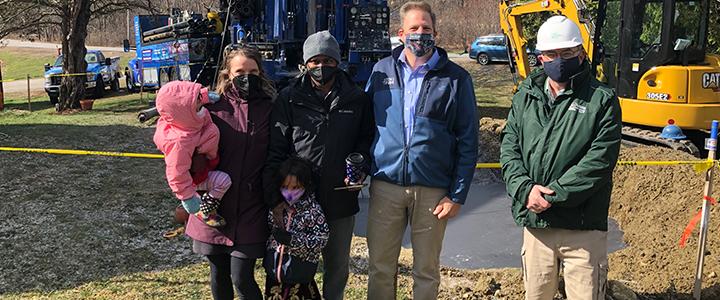
Celebrating Earth Day with the Commissioner
On Earth Day, April 22, NHDES Commissioner Bob Scott toured four NHDES projects and sites to highlight great work being done across the state to protect public health and the environment. The tour started at a Gilmanton home receiving a new well thanks to the Low-Income Residential Drought Assistance Program (DAP). Commissioner Scott was joined by Gov. Sununu to commemorate the program that was created in 2020 to provide short-term relief with the provision of bottled water and financial assistance for activities associated with improving or replacing the homeowner’s well or connecting the residence to an available community water supply.
To date, NHDES has received 88 applications and approved 71 for financial assistance. Ninety percent of the projects are for replacing a dug well with a drilled bedrock well, which solves the lack of water the homeowners are experiencing but also increases the drought resiliency of their water source. The program continues to be a resource for homeowners in 2021.
The Cherussery family’s dug well first exhibited a lack of drought resiliency when it was dry during the summer of 2018. The family used a pond on their property as a source of non-potable water to ease the loss of their supply. Once again, in 2020, the well became dry as drought conditions were exhibited across the state. Even with extreme water conservation measures implemented by the family, the lack of water significantly impacts their daily life.
The Drinking Water and Groundwater Trust Fund Advisory Commission approved funding of $1.5 million to this program in October 2020: Emergency Drought Assistance Initiative (10-23-20).
Commissioner Scott then stopped by the Winnipesaukee River Basin Program (WRBP) site in Franklin – named the most energy efficient wastewater treatment plant in New Hampshire in 2019 – to commend staff for the continuation of the facility’s energy efficiency efforts with the installation of another “turbo” style blower and installing a new emergency, back-up generator. The efficient, diesel generator will provide an estimated 60% reduction in fuel use and reduce electricity generation by the utility; reducing greenhouse gas (GHG) emissions from the WWTP by an estimated 739 pounds/hour of generator run time.
Commissioner Scott went from Franklin to Durham, for a tour of the living shoreline along the tidal portion of the Oyster River at Wagon Hill Farm – the first of its kind in the state. This innovative restoration project was designed specifically to reduce erosion, replace salt marsh habitat, improve shoreline appearance, and accommodate salt marsh migration resulting from sea-level rise. Finished in early 2020, the project will be monitored by the Town of Durham and the University of New Hampshire over the next five years to determine the suitability of the design and whether adaptive management strategies are needed.
The success of the living shoreline at Wagon Hill depends upon thriving salt marsh vegetation. In order to ensure the long-term health of the salt marsh vegetation, visitors should stick to the specified water access point outside of the fence barrier, viewing the living shoreline from the trail or the observation platform (perfect for photos!), and refraining from walking or allowing dogs on the restored marsh surface. To learn more generally about the project, members of the public are encouraged to visit Wagon Hill Farm’s shoreline and view the educational kiosk, which was designed by partners at Strafford Regional Planning Commission (SRPC).
The last stop of the Earth Day tour for Commissioner Scott was at the Londonderry Air Quality Monitoring Station, which is powered by solar panels. NHDES operates a network of air monitoring sites throughout New Hampshire that help us assess the state’s air quality as well as the quality of the air coming from areas upwind and what we contribute to downwind areas. The Londonderry station came online January 1, 2011; the site chosen for its central proximity to the highly populated southeastern suburban portion of New Hampshire.




